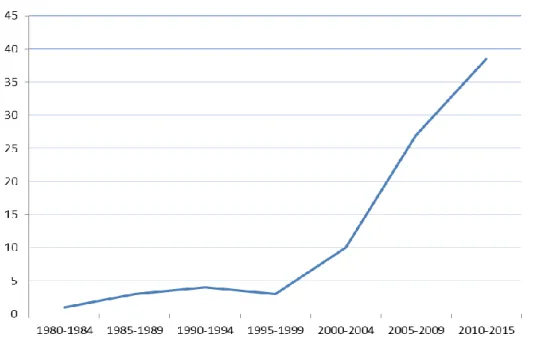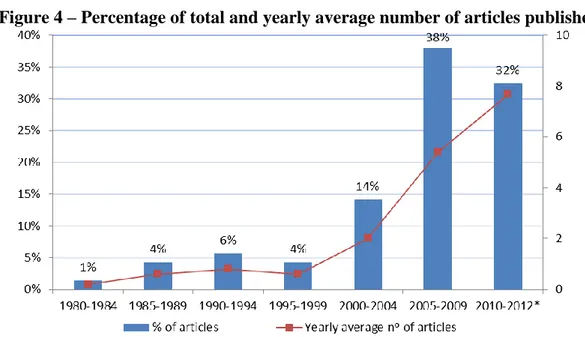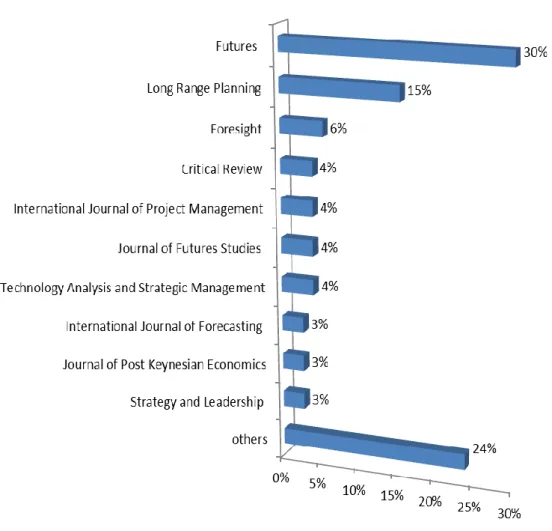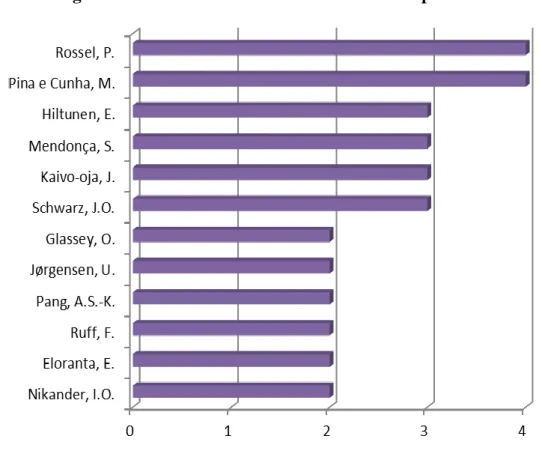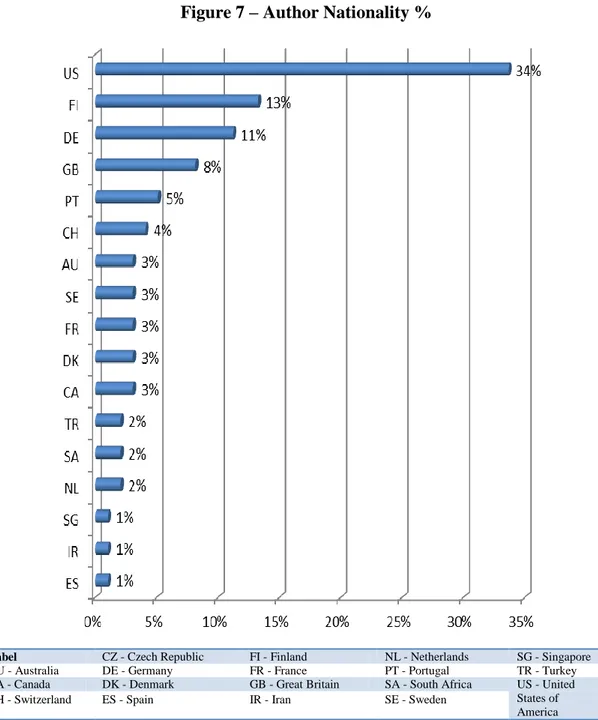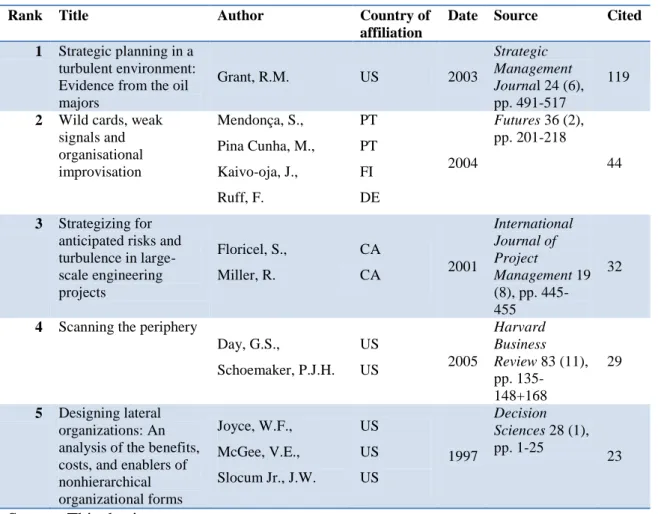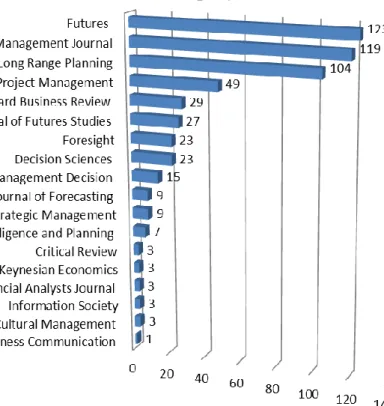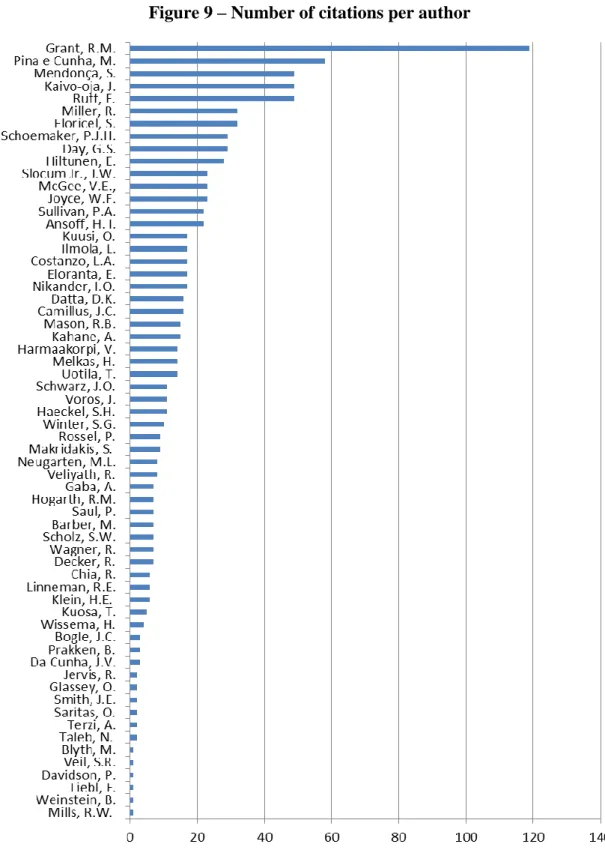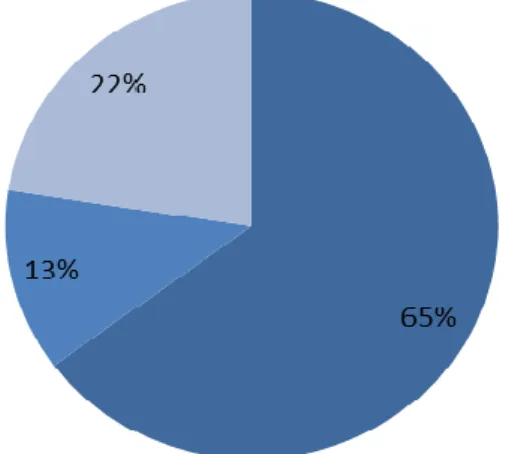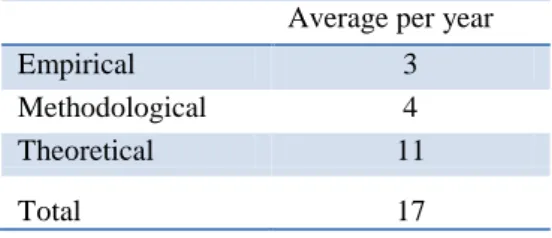WILD CARDS:
SURVEYING EXTREME CHANGE
Bruno Miguel Oliveira Silva
Dissertation presented in partial fulfillment of the Requirements for the
Degree of Master in Portuguese Economy and International Integration
Supervisor:
Sandro Mendonça,
WILD CARDS:
SURVEYING EXTREME CHANGE
Bruno Miguel Oliveira Silva
Dissertation presented in partial fulfillment of the Requirements for the
Degree of Master in Portuguese Economy and International Integration
Supervisor:
Sandro Mendonça,
Assistant Professor, ISCTE Business School, Economics Department
- Lombada –
W
il
d
car
d
s
–
Su
rv
ey
in
g
e
x
treme c
h
an
g
e
Bruno
M
ig
ue
l Olive
ir
a
Si
lv
a
I
Abstract
Socio-economic complexity, quickened by technical change, amplified by globalisation, limits the prediction powers of agents’ actions and increases the need to deal with uncertainty about the future. For many years foresight has been positioned has having a central relevance in the present context of turmoil and insecurity, especially when disruptions and trend-breaking events are of the essence.
Within the subject-area of foresight, however, the concept of extreme sudden change remains still quite unclear. Wild cards, or “high impact”/“low-probability” events, with the potential to redefine the “rules of the game” are a concept worth revisiting given its novelty in the literature and analytical importance in contemporary volatile environments. This thesis focuses on the role and evolution of the concept of wild card in foresight literature. Our main objective is to provide an account of the state of the art of wild card research.
To this end, the methodological approach deployed uses both quantitative data (bibliometric analysis of research papers) and qualitative information (constructivist method based on interviews with experts) as a way of achieving robust insight on what wild cards are as a concept and how they are evolving in the real world. This two-pronged approach allowed for the validation of the findings of the systematic survey of the literature through the lens of the international researchers and practitioners that we were able to enquire.
This methodology is unlike any other we have been able to detect in the extant literature, and may confer this effort a degree of novelty. As far as substantive contributions are concerned, this thesis sought to better distil a definition of the concept of wild card within a foresight’s framework, study its interrelations with other phenomena of change, and also look into the anticipation and adaptation possibilities when dealing with wild cards.
Keywords: Foresight, Wild Cards, Weak Signals
II
Resumo
A intensificação da complexidade socioeconómica, amplificada pela globalização, limita a previsibilidade das acções dos agentes económicos, aumentando a incerteza quanto ao futuro.
Ao longo dos anos destaca-se a contribuição da análise prospectiva para um processo sistemático de antecipação do que o futuro pode reservar. O exame das forças que impelem a evolução da economia, da tecnologia e de outras dimensões da sociedade permitido pela prospectiva, bem como a construção de uma melhor percepção quanto a oportunidades e ameaças na área da política pública e da gestão empresarial, garantem a esta disciplina uma notoriedade num contexto actual marcado por volatilidade, ambiguidade e incerteza.
No seio desta temática mantém-se ainda em desenvolvimento a categoria de mudança extrema e súbita. Os conceitos que visam abordar eventos de baixa probabilidade e alto impacto, de natureza “disruptiva” e com o potencial de redefinir as “regras do jogo”, são ainda recentes e passíveis de aprofundamento. Por exemplo, noções como “wild cards” carecem ainda de definição precisa e perímetro consensual.
O presente estudo debruça-se sobre este objecto de estudo, os eventos-ruptura habitualmente descritos como “wild cards”. A abordagem é de “segunda ordem”, isto é, esta dissertação visa o estudo da teorização do conceito de “wild card”. Para esse fim, foi escolhida uma metodologia integrada combinando elementos quantitativos (através de uma análise bibliométrica) e qualitativos (com levantamento de opinião de especialistas inquéritos a especialistas nacionais e internacionais). Na base deste trabalho de revisão de literatura e de contacto com analistas esta dissertação procura construir uma síntese crítica e criativa do estado da arte e especificar um conjunto de características relevantes para a consideração e adaptação face a “wild cards”.
Palavras Chave: Foresight, Wild Cards, Weak Signals
III
Acknowledgements
First of all, I would express my special thanks and deep appreciation to my supervisor, Prof. Sandro Mendonça for the guidance and support throughout the study. Our meetings and discussions made this thesis possible.
I am especially grateful to all international foresight experts and wild card specialists that took the time of their busy agendas to reply to all my questions. To James Robins, Riel Miller, Ted Fuller, Frank Ruff, Jennifer Cassingena Harper, Karlheinz Steinmüller, Harry Rothman, Elina Hiltunen and Fred Phillips, my warmest thanks. I also want to express my sincerest thanks to the two Portuguese specialists that promptly answered my many enquiries, to José Luiz A. Silva and António Alvarenga. This work would not have been such an exciting learning experience without their testimonies.
A special thanks to all the teaching staff and colleagues at ISCTE-IUL, and all my colleagues and managers at work, for their friendship, availability and patience.
Last but not least I would like to thank to all my family and friends for their support and daily understanding.
IV
Table of contents
Abstract ... I Resumo ... II Acknowledgements ... III List of Tables ... VI List of Figures ... VII List of abbreviations and terms ... VIII Executive summary ... IX1. Introduction ... 1
1.1 First-mover advantages into the radically uncertain future ... 1
1.2 Focusing on “wild card”-related research challenges ... 2
1.3 Methodological approach ... 3
1.4 Structure ... 4
2. Foresight as framework ... 5
2.1 The impertinence of uncertainty ... 5
2.2 The emergence of the foresight research program ... 6
2.3 Modern foresight for economic and business strategy ... 8
2.4 Wild Cards as a complement to standard foresight technique ... 10
2.5 Preliminary conclusions ... 12
3. Wild card and other kind of change phenomena ... 13
3.1 Trends, drivers of change and discontinuities ... 13
3.2 Weak signals ... 14
3.3 Weak signals as advanced indicators of wild cards ... 17
3.4 Wild cards as “unthinkable” change phenomena ... 19
3.5 Wild cards by any other names ... 21
3.6 Wild cards, from concept to policy ... 22
3.7 Categories, typologies, and varieties of wild cards ... 24
V 4. Methodology ... 27 4.1 Data Sources ... 27 4.2 Quantitative evidence ... 27 4.3 Qualitative evidence ... 32 4.4 Preliminary conclusions ... 33
5. Researching wild card research ... 34
5.1 Quantitative analysis ... 34
5.1.1 Published Articles ... 34
5.1.2 Journals ... 36
5.1.3 Authorship ... 37
5.1.4 Accounting for the impact of articles and journals... 39
5.1.5 Research methods ... 42
5.1.6 Target Groups ... 44
5.2 Qualitative analysis ... 45
5.2.1 First person insights ... 45
5.2.2 Wild cards definition and identification ... 48
5.2.3 The importance of disruptive events and of wild cards analysis ... 50
5.2.4 Anticipation and reaction to wild cards ... 52
5.2.5 Emergence of future wild cards ... 54
5.2.6 Examples of wild cards... 55
5.2.7 Wild cards - Concept cloud ... 59
5.2.8 Foresight and wild cards - Portuguese views ... 61
5.3 Discussion of the major results ... 63
5.4 Preliminary conclusions ... 68
6. Conclusions ... 69
7. References... 72
VI
List of Tables
Table 1 – Key words for article search ... 29
Table 2 – Top 5 most cited articles... 39
Table 3 – Average of citations per year per research method ... 43
Table 4 – Articles published per target group and research method ... 44
Table 5 – International foresight specialists ... 45
Table 6 – Editors of the top publications on foresight and future studies ... 46
Table 7 – Portuguese practitioners and scholars ... 46
Table 8 – Biographical information about the experts enquired ... 47
VII
List of Figures
Figure 1 - Steps followed for the selection of the literature ... 31
Figure 2 – Number of wild card relevant articles published per year 1980-2015 ... 34
Figure 3 – Number of articles published per decade ... 35
Figure 4 – Percentage of total and yearly average number of articles published ... 35
Figure 5 – Articles published per journal (%) ... 36
Figure 6 – Authors with more than two articles published... 37
Figure 7 – Author Nationality % ... 38
Figure 8 – Number of Citations per journal ... 40
Figure 9 – Number of citations per author ... 41
Figure 10 – Articles published per research method (%) ... 42
Figure 11 – Articles published per research method and journal ... 43
Figure 12 – Articles published per target group (%) ... 44
VIII
List of abbreviations and terms
3D - Three dimensional
APA - Agência Portuguesa do Ambiente (Portuguese Environmental Agency) BP - British Petroleum
CO2 - Carbon dioxide
DEFRA - Department for Environment, Food and Rural Affairs DNA - Deoxyribonucleic Acid
DPP - Departamento de Prospectiva e Planeamento e Relações Internacionais (Department of Foresight, Planning and International Affairs)
EFMN - European Foresight Monitoring Network
ESPON - European Spatial Planning Observation Network EU - European Union
GE - General Electric
ICI - Imperial Chemical Industries
PESTE - Political, Economic, Social, Technological, Environmental R&D - Research and development
RIG - Reference Impact Grid
SEWS - Strategic early warning system’
STEEP - Social-Cultural, Science & Technology, Energy, Ecology and Economy, and Geo-Politics
USA - United States of America WTO - World Trade Organization WWW - World Wide Web
IX
Executive summary
Increasing turbulence and complexity requires greater ex-ante and ex-post adaptability from organizations if they are to survive and be successful. Under these conditions, constantly re-defined by globalization, technical progress and climate change, organizations are left in need of processes and approaches to deal with uncertainty. This dissertation considers how foresight may be an answer, especially in cases of disruptive events known as “wild cards”. It is assumed that the use of the set of tools associated with foresight:
a) enables decision-makers to build a broader understanding of critical issues and their dynamic context;
b) facilitates pertinent information processing and improves organisational learning; c) fosters recognition of driving forces that may lead to disruptive developments as well as allowing for a better management of the impact of change when it materialises.
Wild cards are one of the most challenging change phenomena. They have been defined as unanticipated, regime-shifting, paradigm-destroying events causing irreversible transformation in the evolution of a system. The key goal of the present project is to appraise the state of the art of wild card research.
In this thesis this inherently multidimensional concept is analysed through the use of quantitative indicators (bibliometric study) as well as qualitative data (enquiries to leading foresight specialists). Thus, this study uses a mix of primary empirical material (the opinion of experts collected for this study) and secondary sources (a systematic literature review conducted with the help of a scientific paper database) to provide a comprehensive, up-to-date and reflexive understanding of wild cards as an emergent foresight concept. Overall, it can be said that the present work was carried out by following the example of foresight’s own reflexive methods, i.e. gathering intelligence for trend analysis on the evolution of the wild card concept and appraising it on the basis of expert opinion analysis.
Through these analyses were obtained a set of information that allows a broader vision of the evolution of this field:
X The total number of relevant articles is 71, coming out mostly in the 2000s,
particularly between 2010 and 2012;
Futures (which published 30% of all the relevant articles), Long Range Planning (15%), and Foresight (6%) are the main journals in this sub-field;
As for impact Futures (123 citations), Strategic Management Journal (119) and Long Range Planning (104 citations) are the most prominent journals;
Regarding authors’ nationality, the majority of them are from the US (34%), Finland (13%), Germany (11%) and Britain (9%);
Concerning the research method, the theoretical articles are predominant (65% of the sample);
As for the identified main target groups, the following were considered: research community (70% of all papers), business organizations and government agencies and departments.
The experts, when asked, defined foresight and, more specifically, wild cards, as major areas of concern. They define wild cards as unexpected and unprecedented events that redefine future trajectories. Eventual anticipation and/or reaction is considered a very difficult task, but essential to survival in an uncertain environment.
1
1. Introduction
1.1 First-mover advantages into the radically uncertain future
As the present work was being completed a number of events shook the world, the European continent, and Portugal in particular. In the week previous to the submission of this thesis several issues punctured news desks. Egypt’s president Mohamed Morsi was ousted by the armed forces (July 3rd, 2013), echoing the “Arab Spring events” and the recent protests in other large emerging nations like Turkey and Brazil demonstrations, going on since June. A Bolivian official airplane carrying President Evo Morales was denied free access in European airspace (July 1st, 2013), an incident fired by suspicions that whistle-blower Edward Snowden was aboard and to which Latin American governments responded furiously increasing diplomatic tensions already high amid European outrage against the electronic eavesdropping by the US National Security Agency. Early that same week Portugal was rocked by the surprise resignation, in close succession, of two top ministers calling into question the continuity of a coalition government and generating costly volatility in a country struggling to accommodate the austerity packages associated to the €78bi “troika” bailout of 2011. All these events were unforeseen by commentators, but were acknowledged as potentially very significant once they happened.
As this small sample of news items shows, the contemporary environment is inescapably characterized by turbulence and increasing dynamism. Technological innovation and the spread of globalisation are phenomena that, at the turn of the twenty-first century, both expanded the number of potential sources of novelty, as well as amplified the reach of the quickening pace of change phenomena. These developing conditions, which tilt progress toward increasing complexity, call for heightened awareness and higher flexibility in decision-making and strategic definition at the corporate and public-policy levels.
This thesis provides a discussion of how “foresight” can and has been be of use to make sense in such environments. The ability to anticipate and quickly adapt to changes (most of the times only emergent and still barely detectable in the horizon) may yield first-mover advantages in dealing with threats and ensuing opportunities.
This can be decisive in an organization’s success. The same is true concerning the importance of steering clear of a possible iceberg ahead.
2 The present work deals with the subject-area of foresight, sometimes also referred to as “futures studies”. Within this broad field this thesis engages with the specific topic of sudden and infrequent, unprecedented and dramatic events. In a word, this study is concerned with the concept referred to in the literature as “wild cards”. In the context of present day severely volatile markets and of unevenly impactful climate change, such themes have gathered significant attention. For instance, such events have been dubbed “black swans” (Taleb, 2009) and “extreme events” (IPCC, 2012), respectively. Thus, in a world increasingly marked by spiked uncertainty the case for a wild card perspective within the foresight perspective is compelling. Current understanding, however, still trails behind its recent rise in the corporate and governmental agendas. We seek to appraise the state of the art of wild card research.
1.2 Focusing on “wild card”-related research challenges
This research attempts to review how wild card and related concepts have been defined and the analytical role ascribed to in the context of foresight and future studies. The interrelation between the concept of wild cards and the one of “weak signals”, i.e. between strategic discontinuities and “early warnings”, also deserves special treatment due to the potential implications regarding wild card anticipation. Wild cards organisational preparedness, given the need to increase resilience in such cases, is also of relevance for our aims.
Analysing the specialized literature on this subject, however, there is a want of surveys that are concerned specifically with the concept of wild card. This dissertation addresses this gap and, in so doing, provides a moving picture of how wild cards studies are evolving as well as identifying current research’s achievements, contributions and future directions. In particular, with this project the goal is to pursue the answers to the following research questions:
a) How is the concept of wild card currently perceived? How to define it? b) What is the role of wild cards within the large network of foresight concepts? c) What achievements? What progress already made and what is ahead?
3
1.3 Methodological approach
A number of decisions were made regarding the theoretical support of this work and the collection of quantitative and qualitative data for analysis. The theoretical background for the concept of wild card and its research was contextualized within foresight’s techniques and tools, alongside other concepts like uncertainty, trends, drivers of change and weak signals. As already mentioned, the relationship between wild cards and weak signals is particularly studied since their interconnection seems especially important in extant research.
In fact, the two concepts are sometimes used as synonyms whereas several authors support that weak signals may provide advance indications regarding wild cards. Definitions and distinctions made on the basis of a systematic survey of the relevant body of published foresight material constitute, therefore, key aims of the present work. The gathering of the data analysed comprised two different stages. In the first stage a quantitative analysis was conducted. A corpus of research articles was identified through a search on a specialised website of the international scientific publisher Elsevier, namely on the SciVerse ScienceDirect platform, part of the Scopus database. The corpus was subsequently used for a bibliometric analysis to study the evolution of the research in a manner akin to that carried out in numerous such analyses such as Teixeira (2008, 2011).
In a second stage, a social constructivist approach, similar to the one employed by Sharif (2006) in his studies of the National Systems of Innovation concept, was adopted. The purpose being to gather key insights on wild cards from experts actively involved in its research. The experts’ answers were compiled following a set of interviews/enquiries to some of the foremost specialists in the subject of foresight and wild cards.
The combination of these two types of empirical inputs, of quantitative and qualitative nature, allows for a comprehensive and integrative study. This “belts and suspenders” approach is methodologically prudent (a safeguard against possible biases) and, at the same time, allows for more up-to-date information on our research topic. In this way, this thesis is positioned itself within foresight’s own reflexive philosophy, i.e., first we
4 conduct an analysis on the evolution of the wild card concept though “hard data” and then we validate this on the basis of “soft opinion” analysis.
The methodology adopted here is unlike any other study we have been able to identify in wild card research or even in the realm of foresight literature at large. It thus can offer, perhaps, a new perspective on what remains one of the more elusive intellectual and management challenges in the area of futures studies.
1.4 Structure
The thesis is organized as follows. Chapter 2 presents the theoretical framework, categorizing the main issues. It goes through four basic themes: foresight as a body of research; trends and trend-breaking events; weak signals; and wild cards. Chapter 3 describes and explains the empirical foundations of the research, namely the survey of secondary sources and the engagement with primary data. Chapter 4 describes the methodology employed on this study and the objectives behind the choices that were made. Chapter 5 comprises the quantitative and qualitative analyses of the key characteristics of the wild card literature in the past 20 years, and discusses the results of the empirical analysis combining them with the findings of the systematic literature survey. Lastly, Chapter 6 concludes with some considerations on the research results and possible future research ambitions.
5
2. Foresight as framework
“The future is too important to be ignored, notwithstanding this difficulty [of predicting the future].” (Kahane, 1992:38)
2.1 The impertinence of uncertainty
What is with the corporate economic system that calls for decision-makers to venture beyond the realm of predictability and even plausibility? Lynch (1995) described modern business environment as “chaotic, fragmented and unpredictable and complex and turbulent” (Lynch, 1995:46 in Mason, 2011:11). Regarding the two last notions, Mason (2011:10-11) defines complexity as a “measure of heterogeneity or diversity in environmental sub-factors such as customers, suppliers, socio-politics and technology” and turbulence as “dynamism in the environment, involving rapid, unexpected change in the environmental sub-dimensions”. As Prakken (2004:57) states, when complexity and dynamics are simultaneously present the result is uncertainty.
A turbulent and unstable environment undermines traditional, linear, rationalist planning approaches (Floricel and Miller, 2001:445). Under unpredictability it is “impossible to know with the necessary precision what to commit to today in order to be successful tomorrow” (Raynor, 2007:4). Given globalization, the rapid evolution of technology, the expansion of human knowledge and the amounting environmental pressures, the uncertainty faced by organizations “is likely not only to continue but to intensify” (Schwarz, 2009:291).1 The specific nature of uncertainty is punctuated by “unanticipated events, crises, and unthinkable or even evil acts [that] require preparedness for unplanned change” (Knowles and Saxberg, 1988:252).
The question, then, is how to make future-oriented decisions when precise forecasting is impossible (Solgaard and Schultz, 1988:155; Saul, 2006:93; Makridakis and Taleb, 2009:840). In other words, how can “organizations in increasingly unpredictable environments (…) manage for today while preparing for the future” (Liebl and Schwarz, 2010:313)? The answer has been that foresight can be an important asset in this pursuit (Laszlo, 1985:20).
1 Schwarz had emphasized this same idea before, stressing that “In the past and even more so in the future, organizations have been and will be subjected to an environment characterized by rapid change and dynamics, and increasing discontinuities” (Schwarz, 2005:22).
6
2.2 The emergence of the foresight research program
Foresight has a long and rich history. By 1931 foresight was already identified by Alfred North Whitehead, at Harvard Business School, as critically important to business (Tsoukas, 2004 in Schwarz, 2009:292). The concept, in its modern meaning, originated in the early post-World War II era at the Department of Defence of the United States of America. The context was in fact the difficulties involved in deciding which projects ought to be funded in an uncertain political-military global environment. These techniques implied using experts’ opinions in a way that sparked the development of the Delphi technique and the explicit use of scenario techniques, all developed in the Rand Corporation during the early years of the Cold War, under the impulse of Herman Kahn (1922-1983) (Bradfield et al., 2005:798; Rossel, 2012:229).
Rand Corporation, set up as non-profit corporation, was born of a joint collaboration between the USA Airforce and Douglas Aircraft in October 1945, first used scenarios for defining strategies relating to nuclear options during the 1950s (Aligica and Weinstein, 2009:267). Herman Kahn left the Rand Cooperation in 1961 to establish the Hudson Institute and so transported scenarios to social prospective and public policy while keeping a multi-disciplinary and long-range outlook (Bradfield et al., 2005:798). Herman Kahn, who joined Rand Corporation early on, is still now referred as the father of the concept (Bradfield et al., 2005:797; Varum and Melo, 2010:356).
In the business arena, scenario planning as an explicit strategy tool was introduced in the early 1970s through the Royal Dutch/Shell experiences (Van Notten et al., 2003:427; Bradfield et al., 2005:799; Varum and Melo, 2010:356). Shell became the ground test for the foresight mind-set and scenario planning.
Under the drive of Pierre Wack in the 1970s and popularized by Peter Schwartz in the 1980s and Kees van der Heijden this was the origin of an Anglo-Dutch school, also referred to as the school of “intuitive logics” or the “Shell approach” (Bradfield et al., 2005:800).
In Europe, foresight studies were also starting in the 1950s (Rossel, 2012:231). Gaston Berger, a French philosopher and futurist, started the Centre d’Etudes Prospectives in the mid-1950s where the school of La Prospective emerged (OECD 1970:147).
7 La Prospective, which also included a scenario planning approach, aimed at the development of scenarios to frame political debate and action. The approach was geared toward the integration of fragmentary projections of many sectors into coherent but contrasting socio-economic wholes that would surpass the tendency toward partial and linear view of the future. Troubled with France’s socio-political future, Gaston Berger emphasised that the future was not a “‘predetermined temporal continuity’ but something which is to be created and which can be ‘consciously modelled to be humanly beneficial’” (Bradfield et al., 2005:802).
In the 1970s, Gaston Berger’s French School was re-energised by the methodological contributions on scenario building of Michel Godet, at the time head of the Department of Future Studies at SEMA, a firm linked with the French defence sector (Bradfield et al., 2005:802). Godet (1986) emphasised the notion of many possible, changeable and constructible futures (les futuribles), rather than just a predetermined one, stating that:
“The future is not written, it remains to be carried out. The prospective process admits that, at any given moment, the future is multiple and that from the confrontation between the various actors [we] will derive one future rather than another” (Godet 1986:136 quoted in Martin, 2010:1441).
In spite of many similarities (Martin, 2010:1441), one of the foremost differences between the Anglo/Dutch-American School and La Prospective is each one’s focus. While the French school focused more on a public socio-political analysis at the country level, the Anglo/Dutch-American School leaned to a more worldview-level nature (Bradfield et al., 2005:803; Voro, 2006:49). Michel Godet, one of its key proponents, considers two main functions for La Prospective: 1) the identification of the organization's capacity and strategy; 2) helping the organization to make strategic choices. Thus, for Godet, first it is necessary to identify the key variables that best characterise the system and then perform an analysis of actors and their linkages and relationships. On this basis scenarios are built taking into account those variables and actors (Correia and Carvalho, 1997:61-62).
As for Peter Schwartz, he sees foresight and scenarios in long-term strategic planning as a way to analyse the set of “possible-logical” driving forces, to foster organizational learning and to better allow decision-making and strategy identification (Correia and Carvalho, 1997:26).
8 In fact, Constanzo (2004) describes foresight as a mechanism for “probing and learning”, through which organizations can envision several futures and take steps towards a desirable one, thus becoming not only a method for anticipating change, but also for inducing change within the organization (Constanzo, 2004).
In the 1980s and the 1990s there was a considerable slowdown in planning activities, specially by key corporations like General Electric (GE) , British Petroleum (BP) and Imperial Chemical Industries (ICI), mainly because “there was minimal payoff associated with employing planning staff and specialists to formally guide the firm’s future” (Veliyath, 1992:86). However, in the 2000s a renewed interest in the concept of foresight was rekindled, with an increase of publications in this area (Martelli, 2001; Steinmüller, 2004; Bradfield et al., 2005; Varum and Melo, 2010).
2.3 Modern foresight for economic and business strategy
Foresight is thus a result of the “hot-house” atmosphere at the height of the Cold War. On both sides of the Atlantic particular organisations (not-governmental, not-for-profit) developed a set of theoretical assumptions (the future is a plural canvas yet to be stabilised), methodological pre-requisites (combining hard-data and expert opinions) and pragmatic orientation (mapping possibilities into strategic priorities).
Plugged into these historical roots contemporary futures studies researchers define foresight along lines such as these:
“a process that attempts to broaden the boundaries of perception in four ways: By assessing the implications of present actions, decisions, etc. (consequent assessment); By detecting and avoiding problems before they occur (early warning and guidance); By considering the present implications of possible future events (pro-active strategy formulation); By envisioning aspects of desired futures (normative scenarios)” (Slaughter, 1995 in Uotila et al., 2005:852).
9 Thus, foresight can be classified as a “search” behaviour (Fidler, 2011:542), and consequently a key input in the strategic planning of organizations. This strategic philosophy can accommodate different kinds of specific methodologies and tools, such as:
“1) forecasting, envisaged in the strict sense of calculating possible trajectories based upon past series of data; (2) Delphi exercises, making good use of multi-expert knowledge to put next steps of a given problem into perspective; (3) simulations, based upon some form of systems thinking; and (4) scenario developments, often combining several of these methods” (Rossel, 2009:310).
In fact, recently, the renewal of the investigation in this subject showed an increased attention on the classification and organization of the existent literature, emphasizing the strengths and weaknesses of each methodology through the construction of systematic overviews (Varum and Melo, 2010:356).
Several surveys were published throughout this decade, Chermack et al. (2001), Martelli (2001), Bradfield et al. (2005), Börjeson et al. (2006), Bishop et al. (2007) and Varum and Melo (2010); and also several typology exercises namely of Van Notten et al. (2003), Voros (2006), Börjeson et al. (2006); among several others that could be cited.
Since precise forecasting is typically impossible to obtain in the economic and business world (Makridakis et al., 2009:794), the fact is that in modern strategic management the ability to react quickly to changes, thus turning them into opportunities rather than threats, is essential to success (Camillus and Datta, 1991:73). That is the gap foresight is designed to fill since “(i)nstead of attempting to predict what is going to happen (…)”, allows the organization to “(…) see the forces as they are taking shape and not be blindsided when they lead to major changes” (Randall, 2009:27).
For all this reasons, “The role of a foresight process in an organization is not so much to predict the future, but to prepare for it” (Tsoukas and Shepherd, 2004 cited in Schwarz, 2009:292). Disregarding the need for foresight might result in “looking too hard in one direction, by neglecting both context and periphery while ignoring the discarding of information that is taking place” (Neugarten, 2006: 894).
Foresight facilitates pertinent information processing and analysis, allowing the organization to prepare for the impact of these changes, which can be decisive in its
10 future2. Foresight is then “a process by which one comes to a fuller understanding of the forces shaping the long-term future which should be taken into account in policy formulation, planning and decision-making” (Coates, 1985 in Martin, 2010:1440). One of the most important purposes of anticipatory scanning is then to reduce the environmental uncertainty (Klein and Linneman, 1981:69; Veliyath, 1992:87). Because “most companies tend to be myopic and miss important developments in adjacent and influential industries and societal areas” (Lindkvist, 2011:3), the exercise of foresight allows for a less biased awareness of the future3.
Systematically analysing the forces more likely to influence that future and examining “what chances for developments and what options for action are open at present, and then follow up analytically to determine to what alternative future outcomes the developments would lead” (Solem 1986:4 and Martin and Irvine, 1989:5 in Martin, 2010:1441).
Since organizations incorporate into their routines experience from past situations to solve new problems, if these problems are relatively similar to those faced in the past that experience can be slightly adapted to overcome those obstacles. The problem is that “history never repeats itself in exactly the same way” (Makridakis and Taleb, 2009:841). Foresight allows organizations to “Overcome the usual errors in decision-making: overconfidence and tunnel vision” (Schoemaker in Varum and Melo, 2010:356).
2.4 Wild Cards as a complement to standard foresight technique
Scenarios are a classic and popular methodological platform for carrying out futures-oriented research. One of foresight’s best known and more widespread techniques, the construction of scenarios, nor only allow the comprehension but also the design of several possible futures (Klein and Linneman, 1981:69; Martelli, 2001 in Varum and Melo, 2010:356; Schwarz, 2009:291). Scenarios are long used as an instrument for
2
Martinet (2010) underlines the interest of the set of tools associated with foresight, as a way to “enable
the organization to identify, as soon as possible, weak signals, threats and opportunities which can occur and to monitor the constant transformation of capabilities, cultures, structures and management processes in a coherent way” (Martinet, 2010:1486).
3
Georghiou and Harper (2011) also argue the importance of strategic foresight to counter organizations’ myopia, considering that in an unstable environment, full of unknowables and in constant mutation, foresight can allow an organization to avoid short-term action and reactive thinking, and enable a more integrated thinking (Georghiou and Harper, 2011:248).
11 surveying future paths, dating back to Plato’s “Republic”, Thomas More “Utopia” or military strategic planning (Bradfield et al., 2005: 797), their purpose being “(…) to sensitize us to recognize signals of possible changes in the world (…) and to enable us to respond quickly and appropriately. They are less reassuring than conventional forecasts, but more challenging-and therefore more useful” (Kahane, 1992:46).
Scenario planning is a standard instrument to address the multiplicity of possible plausible futures and their inherent unpredictability (Lempert, Popper and Bankes, 2003:29).
Rather than engaging in the traditional search for optimal strategies - based on fixed assumptions about the future that may prove incorrect - scenario planning allow the definition of robust strategies, that perform “reasonably well compared to the alternatives across a wide range of plausible futures” (Lempert, Popper and Bankes, 2003:52). Regarding the analysis of scenario planning, Varum and Melo (2010:362) have identified two main streams within the thematic literature.
A first group of studies that examines the importance of scenarios as a strategic management tool, defended by authors like Skudlark and Ahn (2002), Miller and Waller (2003), Raynor and Leroux (2004), Masch (2004) and Cornelius et al. (2005), among others, which underline the capabilities of scenarios as facilitators of decision-making in a constantly changing environment. These studies define scenario planning as an opportunity to envision plausible future states, in order to help identifying possible strategies to take advantage of opportunities and avoid potential threats.
Another group of studies, such as de Geus (1988), Winch (1999), Martelli (2001), Winch and Arthur (2002), Wright (2005) and Roubelat (2006), is more concerned with the exercise of constructing scenarios, considering “scenarios as an instrument for institutional and organizational learning” (Varum and Melo, 2010:362).
Even though scenario planning is one of the most used tools in foresight, some authors state that scenario planning sometimes fails in the identification of unforeseen events, missing, disregarding or misreading the weak signals available (Liebl, 2004; MacKay and McKiernan, 2004; Neugarten, 2006; Postma and Liebl, 2005 in Schwarz, 2009:293). Driven by the past and not the future, “scenario planning processes are often little more than projections crafted onto past experiences” (Oriesek and Friedrich, 2003 in Schwarz, 2009:293). A key contention is that they must be integrated with other tools like weak signal scanning and wild cards analysis (Mendonça et al., 2004).
12 As Horton (1999) argues a successful foresight process must have three consecutive stages: the gathering of the available information and knowledge; the interpretation of this knowledge; and the assimilation and assessment of that understanding (Horton, 1999 in Uotila et al., 2005:853). The consideration for novel and disruptive factors, known as wild cards, may be inserted in these three stages. In fact, it should be noted that “today's policy choices have to be evaluated not only in the light of current policy goals but also in the light of possible, sometimes dramatic, future events.” (Smith and Dubois, 2010:846).
2.5 Preliminary conclusions
Foresight assumes increasing importance as a way to navigate a constantly shifting world; its set of tools and processes address the need of dealing with the unknown, fostering organizations’ rapid and flexible response to change.
Foresight also promotes increased peripheral view allowing organizations to better perceive business conditions and overcoming tunnel vision and blind spots. This is of value, especially, in what concerns change of extreme kinds.
Integrating a wild card analysis scheme with standard foresight technique enables a wider and more comprehensive perception of what the future might bring. The next Chapter will focus on the set of issues in and around the concept of wild cards. It will trace its theoretical evolution trying to clarify its boundaries regarding other phenomena of change.
13
3. Wild card and other kind of change phenomena
“The world is not what we used to think it is, a kind of giant mechanism obeying eternal laws in a predictable and deterministic fashion.”
(Laszlo, 1985:4)
3.1 Trends, drivers of change and discontinuities
In foresight analyses there are several critical forces that enable a better understanding of what the future might bring. In that regard it is important to understand the relevance of some key concepts like trends, drivers of change and discontinuities. This Chapter undertakes a literature review of the established foresight research on wild cards.
It is possible to define trend as a wide phenomenon identified by several actors; generalized and transversal; experienced by everyone in similar contexts; with the potential to “create broad parameters for shifts in attitudes, policies and business focus over periods of several years that usually have global reach (…) they are larger than the power of individual organizations and often nation states as well.” (Saritas and Smith, 2011:294). Trends are characterized as “(…) ongoing, fundamental societal change over an extended period (…) [or] a short term phenomenon, e.g. in fashion or music” (Schwarz, 2005:23). Eventually, they can even become “heavy trends” or “megatrends”, the latter as defined by John Naisbitt (1982), referring to tendencies growing and shifting gradually, only influenced in a certain degree since “A megatrend contains several and even contradictory sub-events and series of events.” (Naisbitt, 1982 in Holopainen and Toivonen, 2011:4).
As for drivers of change, they are critical uncertainties with great potential impact on organizations or their institutional environment. They arise as the result of conscious or unconscious choices in different fields (investment, policy, strategic options), thus being susceptible to changes in these factors. Although similar to trends, drivers do not have an impact as transversal, but are usually more aimed on certain economic activities or areas (Holopainen and Toivonen, 2011:4).
14 In short, drivers of change are “factors, forces or events – developments which may be amenable to changes according to one’s strategic choices, investments, R&D activities or foresight knowledge and strategies. They are both presently accessible and future relevant.” (Saritas and Smith, 2011:295).
Regarding discontinuities, these are significant changes in the pre-existent trajectories; one of the most usual examples cited is the one of technological discontinuities. Discontinuities pose a threat to the more inflexible organizations more related to old technologies, but also opportunities for more aware organizations. Following the concepts of gradual discontinuity and abrupt discontinuity, as defined by van Notten et al. (2005), it is possible to define the first concept as “transition”, i.e. as a “change of paradigm and the introduction of new practices and rules” involving periods of “slow and fast development”, and the second related to the “instantaneous nature of change [as] the distinguishing feature of abrupt discontinuities, [giving] society a jolt, even if it is of a temporary and reversible nature” (van Notten et al., 2005:180-181,190). Therefore, abrupt discontinuity is a concept much closer to the one of wild cards.
Gradual change such as trends or slow transitions is slower and can be expected in advance, giving organizations additional time to react (Hiltunen, 2006:67). By contrast, wild cards are the opposite of gradual change, they are inherently uncontrollable change. An important issue is thus how to anticipate them.
3.2 Weak signals
Accurate advanced information is essential to resilient and path-creating organizations and countries (Mendonça et al., 2012:218). Foresight methodologies enable an integrated thinking that helps organizations develop contingent strategies in unstable environments, essential in strategic definitions (Barber, 2006:82). An important concept, still in its early phases but already vastly present in the literature is the concept of weak signals, also referred to as emerging issues (Hiltunen, 2006:64) and early warnings (Petersen, 1999). If trends, drivers of change and discontinuities can be thought of as the “winds of change”, then weak signals are the first whispers. Listening carefully enough may even allow one to weather the storm.
15 In the early 1960s, the concept of weak signals can be immediately detected in the French school of La Prospective where, in 1964, Pierre Massé mentioned the concept of “faits porteurs d’avenir”, that is, developments today that are pregnant with what tomorrow will bring (Rossel, 2012:231). Godet (1993) further strengthened this vision defining weak signal as a germ, ‘‘a factor of change hardly perceptible at present, but which will constitute a strong trend in the future’’ (Godet, 1993 in Kuosa, 2010:43)4. Weak signals were debated further in the works of Aguilar (1967) and particularly developed by Igor Ansoff, in the 1970s and at the beginning of the 1980s (Rossel, 2012:230). Ansoff was one of the first to deepen the definition of weak signals as a complement to the notion of strategic planning. Ansoff borrowed his weak signal metaphor from the information theory, defining the concept as early symptoms, imperfect warnings, that could be internal or external, and partial and incomplete (Ansoff, 1984:369; Rossel, 2009:308; Mendonça et al., 2012). He believed that all events would have to go through a series of stages from “weak signals” to “strong signals” (Ansoff, 1984:21; Nikander and Eloranta, 1997:371; Mendonça et al., 2004:206).
He stressed “that the firm had to cope with changes, some of them not necessarily expected and that one could characterize this changing environment as turbulent” (Rossel, 2012:230). He also argued that whereas strategic planning is rather useful in gradual changing environments where “strong signals” are available, it has several limitations when facing surprises/unexpected events. Consequently, he defended that a weak signal approach is necessary to expand the flexibility and improve the reaction time of organizations (Ansoff, 1984:384; see also Rossel, 2009:307; Holopainen and Toivonen, 2011:1-2; Rossel, 2012:230).
Weak signals are usually described as a tacit (subjective and hard to quantify) or explicit (more clear) form of knowledge (Kaivo-oja, 2012:207). According to Web (1987) some signs may not be detected, or be hardly noted, because the attention is centred elsewhere. Also, there are filters between the original signal and its receptors that may diminish its strength (Webb, 1987:12-14 in Hiltunen, 2006:71).
4 Kamppinen, Kuusi, and Söderland (2002) and Rossel (2009) define weak signal similarly, as an event,
or events, that may not seem to be vital in the present but that may have a significant importance in the future (Kamppinen et al., 2002 in Holopainen and Toivonen, 2011:3; Rossel, 2009:308). This view is also shared by Saritas and Smith (2011) and Heinonen and Hiltunen (2012) whom consider weak signals as the earliest information concerning future changes, possible yet still unconfirmed; the first signs or symptoms of paradigm shifts, big changes, future trends, drivers, discontinuities, growing trends, or even megatrends (Saritas and Smith, 2011:297; Heinonen and Hiltunen, 2012:255).
16 Saul (2006) considered weak signals as “ambiguous and controversial bits of information about the competitive environment that are typically hidden among the "noise" of the prevailing sensemaking paradigm and that gradually coalesce to form a pattern of intelligence that alerts sensitive leaders that it may be time to change their game” (Saul, 2006:93).
Thus, a weak signal is information yet to be structured, with unclear consequences (Ilmolaa and Kuusi, 2006:911). A concept close to the ones of emerging issues, seeds of change and early warning signals, sometimes even used as synonyms (Hiltunen, 2008b:247; Glassey, 2009:321).
To Coffman (1997c), weak signals are dispersed data, diffused over time through several sources and channels of communication, which can indicate an arriving wild card. They are ideas or information pre-announcing developments that can disturb and affect organizations, difficult to identify amongst “general noise”, startling and unforeseen to the receptor; though others may have seen it coming sometimes, they are scorned even by experts. They usually are not yet mature, with a delay before becoming mainstream. If caught early, these signs can constitute an actual opportunity instead of a threat, a chance to innovate, learn and grow (Coffman, 1997c; Mendonça et al., 2004:206; Decker et al., 2004:190; Holopainen and Toivonen, 2011:3).
Therefore, to “achieve and sustain competitive advantage, companies in turbulent environments need to scan the business environment to capture weak signals of early opportunities. If they are captured, activities on the periphery can be a source of new strategic insight” (Ilmolaa and Kuusi, 2006:909)5.
Weak signals can be of all kinds of sources: of human nature (internal or external); of textual nature (published and internal documents sources); and of online nature (internet sources) (Hiltunen, 2008a:24). For instance, nowadays the World Wide Web and Social Media are seen as new and border sources for weak signal detection (Decker et al, 2004:190; Pang, 2010; Pang, 2012:35; Glassey, 2012:257).
5 Several authors emphasize the importance of peripheral vision as a way to enable organizations to
expand horizons (Ansoff, 1984:334; Day and Schoemaker, 2005; Holopainen and Toivonen, 2011:5; Kaivo-oja, 2012). Systematically scanning for weak signals on the periphery of their field of vision, outside of their usual boundaries, allow organizations to counter “tunnel-vision” and the constant stumble on the unexpected (Neugarten, 2006: 901).
17 A key advantage of weak signals is their potential value for announcing discontinuities, in advance, namely wild cards, that is, those “sudden and urgent changes in the firm’s perspective which threaten either a major profit reversal or the loss of a major opportunity” (Ansoff, 1984 in Holopainen and Toivonen, 2011:2). Weak signals are seen as hints and glimpses of information, available before a major shift in the existing paradigm to an unfamiliar path (Mendonça et al., 2004:205).
3.3 Weak signals as advanced indicators of wild cards
It is accepted that shocks, strategic surprises and discontinuities do not necessarily arise devoid of warning signs. Consequently, early detection could lead to “quickly spot those signals that are relevant and explore them further, filter out the noise, and pursue opportunities ahead of the competition or recognize the early signs of trouble before they escalate into major problems” (Schwarz, 2009:292). On the contrary, organizations blind to weak signals tend to drive “through red light[s] [that is] (…) not noticing, ignoring, suppressing or scorning warning signals which, if properly addressed, would have contributed to preventing an incorrect decision” (Wissema, 2002:522).
Weak signal is a concept close with the one of wild card, sometimes even used as synonyms by some authors (Hiltunen, 2008b:247; Rossel, 2009:308; Glassey, 2009:321). For instance, Mannermaa (1999) first considered both weak signals and wild cards as a single concept, as unprecedented surprises with the potential to become “central phenomena or influential factors” in the future; later, Mannermaa (2004) defined weak signals very similarly to wild cards, as low probability and high impact phenomena (Mannermaa, 1999, 2004 in Hiltunen, 2006:63). However, weak signals are now normally assumed as a way to anticipate the advent of a wild card (Petersen, 1999; Cornish, 2003; Mendonça et al., 2004; Hiltunen, 2006:62, 71; Holopainen and Toivonen, 2011:3; Rossel, 2012:236).
It is also underlined that “weak signals are connected [to] a variety of options from moderately uncertain to very uncertain events and issues, while wild card analysis focuses on very uncertain events and on potential events that are likely to have rather significant impacts”(Kaivo-oja, 2012:209).
18 The distinction between the two terms can be seen in the work of Ansoff, in which he stresses how weak signals provide early information in the identification of strategic discontinuities and strategic surprises, advocating the utilization of early weak signal analysis as a preparation for a fast response to change (Holopainen and Toivonen, 2011:3-4).
Consequently, some authors suggest that a wild card analysis methodology “can be decomposed into two main activities: wild card imagining and weak signal scanning” (Mendonça et al., 2009:28). By scrutinizing the decision environment, weak signal scanning can be useful in the anticipation of wild cards (analytically useful) thus improving the capacity to deal with changing environments (managerially useful) (Mendonça et al., 2004:201).
As a prelude of trend breaking crises, warning signs may arise. The possibility is there for those the most aware to read them (Mitroff, 1988). Early scanning and weak signals detection can allow ways to anticipate major discontinuities and facilitate preparation and adaptation (Mendonça et al., 2009:24). So, the central benefit of weak signal analysis is that organisations will take less time to react, saving time when the (un)anticipated event occurs (Haeckel, 2004:182,185; Hiltunen, 2006:62; Holopainen and Toivonen, 2011:2). In fact, “even if an organization cannot act to prevent a crisis once in motion (such as an impending natural disaster or even economic recession), recognition of warning signals (...) allow for planning to minimize the consequences” (Veil, 2011:120).
Schwarz (2005) discusses the concept of a “strategic early warning system’’ (SEWS) as a technique that enables organizations to prepare for early responses to crises, emphasizing at the same time that the lack of SEWS has been listed as one of the key causes of failure in strategic planning within the German corporations (Schwarz, 2005:22). However, weak signals themselves are useless if not acted upon after their identification, which is why “the impact of a weak-signal cannot be quantified on a deterministic scale, because this usually depends on the actions that follow the signal” (Decker et al., 2004:192).
But it must be bared in mind that while “postulating a particular wild card makes it rather natural to envisage possible weak signals. On the contrary, considering anything as a weak signal, without a scenario, context, perspective or criss-crossing factor
19 substantiating some sense-making claim, is only a temporarily valid exercise that does not necessarily induce associated wild cards” (Rossel, 2012:236).
So, through the methodology suggested by Mendonça et al. (2009) an organization would be able to scout beyond its usual borders using information mining and filtering, exploring the periphery and thus being able to identify technologies, processes, competitors or trends that may drive future strategic uncertainties. At the same time, continuously stimulating the organization to consider alternative views and challenge static or preconceived ideas, allowing for lateral thinking.
As Ansoff defined it, weak signal analysis improves the organization consciousness and knowledge, its malleability to new situations, and its direct reaction to the opportunity/threat (Holopainen and Toivonen, 2011:2).
Therefore, the combination of weak signal sensing with an active wild card practice scheme significantly increases the organization’s flexibility, fostering its awareness. Thus, allowing for an “organizational state of mind more equipped to face unfamiliar prospects and consider innovative responses in the wake of wild cards” (Mendonça et al., 2009:28).
3.4 Wild cards as “unthinkable” change phenomena
Herman Kahn (1962), the pioneer of foresight, stressed that it is in fact necessary to “think about the unthinkable”. Unanticipated events are bound to happen in a continuously changing world, full of surprises, discontinuities and shocks. Thus, we are forced to embrace the improbable, to consider the implausible, and to allow for what was deemed impossible. The concept of wild cards brings in to a sharp focus this important paradox, one that contemporary organizations cannot afford to overlook (Knowles and Saxberg, 1988:254).
Looking into the meaning imbued in the concepts’ designation, the Oxford dictionary defines wild card as:
“1 - playing card that can have any value, suit, colour, or other property in a game at the discretion of the player holding it;
2 - an opportunity to enter a sports competition without having to take part in qualifying matches or be ranked at a particular level;
3 - person or thing whose influence is unpredictable or whose qualities are uncertain.” (Oxford dictionary, 2013).
20 The original poker term for wild card meant a card in a deck of playing cards that can be given any value by its owner. Consequently, implying a high level of control for the holder of such knowledge and a risk to the other players that don't know what value will be given to the card, or when it will be drawn from the deck. As such, the term evokes the “unknown” and the notion of “surprise”, on a subjective point of view, since the impact of a wild card can be devastating for some and extremely positive for others. A wild card completely changes the game, for better or worse…
Wild cards are regime-shifting, paradigm-destroying events, altering existing trends or generating new ones, causing irreversible transformation in the evolution of the organization/system (Mendonça et al., 2009:25, 26)6. As an analogy for wild cards it is at times referred the notion of mutation. Due to exogenous or endogenous factors, sometimes organisms’ DNA can be subjected to permanent change.
That change, a mutation, can have a tremendous impact on the organism’s life or no impact at all, its consequences ranging from extremely negative to extremely positive. Therefore, using this comparison, wild cards are the most extreme mutations.
Hence, due to the potential impacts of a wild card, serious attention must be given to anticipatory methods that can allow an organization not only to prepare for the aftershock, but also help to define a more robust business and management strategy. Ideally, this strategy could minimize the negative impacts and maximize business opportunities within the new, post-event, landscape (Knowles and Saxberg, 1988:254; Saritas and Smith, 2011:295-296; Markley, 2011:15).
Wild card analysis is a conceptual tool to support the contemplation of alternatives beyond the present state of the art, the existing framework and the contemporary thinking (Barber, 2006:78). Wild cards are often used to test the stability of scenarios regarding unforeseen events and the effect of several imagined, high impact, events. A basic step may be the introduction of a wild card within a scenario to flesh out what options and choices were and can be available. Therefore, this concept amplifies the foresight scope and the resulting organizational learning (Mendonça et al., 2009:31; 34). So, while scenarios are aimed at the imagination and understanding of possible futures, based on past actions and choices, the wild cards test the reaction of the system as a measure of its resilience (Smith and Dubois, 2010:847).
6 Wild cards are generally defined as shocking events with massive magnitude (Hiltunen, 2006:64), with
21 Hence, a wild card is a foresight tool used in a more profound futures analysis, since “They are not “seen in normal play” they produce a result despite a lack of sufficient information (…) and have a large degree of unpredictability” (Barber, 2006:76).
3.5 Wild cards by any other names
It is a challenge to define what a wild card is. The concept is sometimes used broadly as a synonym of surprises, discontinuities, disruptive events, structural breaks, bifurcations, systemic breaks, shocks, abrupt and discontinuous bursts, faits porteurs d’avenir, dislocations, trend breaches, paradigm busters, etc. (Mendonça et al., 2004:203; Van Notten et al., 2005:178; Hiltunen 2006:62)
Parallels can also be drawn with the notion of crisis, defined as “a period of sudden change during which a totally new system is formed”, with the meaning of crisis not only covering “risk, uncertainty, threat, conflict, accident, and instability but also opportunity” (Sofuoglu and Basoglu, 2008:811). Booth’s (1993) definition of crisis adds to this view, since he considers it “a situation faced by an individual, a group or an organization, which they are unable to cope with, by the use of normal routine procedures and, in which stress is created by sudden change” (Booth, 1993:86).
Alternative nomenclatures for the concept of extreme change have been forwarded by some authors, namely Nassim Taleb’s “black swans” (2007) and Oliver Markley’s “STEEP surprises” (2011), a term which Markley defends as a more accurate designation for the concept than wild card.
The term of “black swans” derives from the belief, prevalent before 1697 (when the Dutch explorer Willem de Vlamingh explored the Swan River in Western Australia), that all swans were white. When black swans were identified in Australia, the concept of “black swans” was considered a metaphor for something that was untold and hard to believe in (Des Dearlove, 2009:59; Runde, 2010:493), a case later used by thinkers such as Karl Popper, the philosopher of science.
Nassim Taleb (2007) imported and popularized this expression in his book, The Black Swan: The Impact of the Highly Improbable. This contribution, published ahead of the international financial crisis known as the “Great Recession” or the “Little Depression”, addresses radical uncertainty and the epistemic challenges posed by problems with “outlier status” (Des Dearlove, 2009:59; Runde, 2010:493).
22 He defines “black swans” as:
“(…) an event that lies outside the realm of regular expectations, because nothing in the past can convincingly point to its possibility. Second, it carries an extreme impact. Third in spite of its outlier status, human nature makes us concoct explications for its occurrence after the fact, making it explainable and predictable. These perturbations are not only large, they have lasting effects” (Taleb, 2007:xvii–xviii).
According to Taleb, a “black swan” is an event with three core properties: 1) it is an unexpected event (“outside our tunnel of possibilities” – outlier); 2) with major repercussions (“an extreme impact”); 3) and explainable after its occurrence (only cognitively manageable ex-post) (Bogle, 2008:30; Runde, 2010:493).
3.6 Wild cards, from concept to policy
Among the specialized literature on foresight theory and methodology, there are several definitions of the concept of wild cards. They are usually defined as high-impact, low-probability events, with the potential to cause major disruption, nearly impossible to predict due to their rare or even unprecedented nature (Rockfellow, 1994:14; Petersen, 1997; Cornish 2003:19; Mendonça et al. 2004:203; Barber, 2006:77; Voros, 2006:47; Saffo, 2007:1; Mendonça et al., 2009:24; Smith and Dubois, 2010:847).
The notion is intertwined with Ansoff’s strategic surprises theory, where these strategic surprises are defined as a major opportunity or loss to the enterprises: “sudden, urgent, unfamiliar changes in the firm’s perspective that bring the threat of either a major profit reversal or loss of major opportunity” (Mendonça et al., 2009:24).
John Petersen (1999), one of the first to further define the concept, categorized wild cards broadly as big surprises, with a shock effect, significant and direct results, ample and substantial implications; hampering the existent system possibility to quickly adjust to the shock (Petersen in Barber, 2006:77).
Wild cards are trend-breaking/creating events, so this concept can be thought as meaning an incident or episode that, arriving by total surprise, has an extensive impact in the system dynamics – becoming a turning point in the registered development (Barber, 2006:77; Mendonça et al., 2004:201; Mendonça et al., 2009:23).
